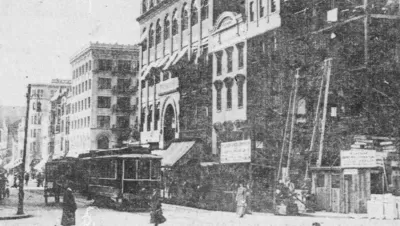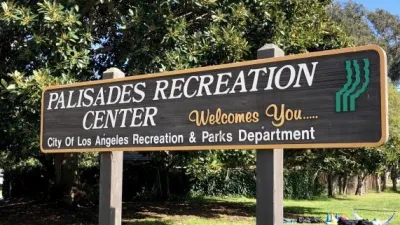Yes, there was a conspiracy led by General Motors to replace streetcars with their buses in the 1930s. But streetcars were dying well before then, due to competition with the automobile and other reasons apart from nefarious corporate collusions.

Joseph Stromberg of Vox provides yet another reminder that the convenient scapegoat for the death of public transit in the United States can not be laid at the doorsteps of General Motors. [If you haven't read Stephen Smith's 2010 article in Market Urbanism about the conspiracy and how it is misinterpreted by some in the planning profession today, it's summarized and linked here.]
"There's this widespread conspiracy theory that the streetcars were bought up by a company National City Lines, which was effectively controlled by GM, so that they could be torn up and converted into bus lines," says Peter Norton, a historian at the University of Virginia and author of Fighting Traffic: The Dawn of the Motor Age in the American City.
But that's not actually the full story, he says. "By the time National City Lines was buying up these streetcar companies, they were already in bankruptcy."
For the record, there was a conspiracy according to the 1949 U.S. Supreme Court's ruling in UNITED STATES v. NATIONAL CITY LINES, Inc., et al. But can General Motors, as well as Firestone Tire, Standard Oil of California, Phillips Petroleum, and Mack Trucks (the other companies found guilty in the lawsuit) be blamed for tearing up almost 17,000 miles of streetcar tracks?
"The real reasons for the streetcar's demise are much less nefarious than a GM-driven conspiracy — they include gridlock and city rules that kept fares artificially low — but they're fascinating in their own right, and if you're a transit fan, they're even more frustrating," writes Stromberg. I would add that if you're a transportation planner and/or advocate, it's even more reason to get the story straight as those problems apply to some degree today, as posted here and here.
The real problem was that once cars appeared on the road, they could drive on streetcar tracks — and the streetcars could no longer operate efficiently. "Once just 10 percent or so of people were driving, the tracks were so crowded that [the streetcars] weren't making their schedules," Norton says.
While it's true that National City continued ripping up lines and replacing them with buses — and that, long-term, GM benefited from the decline of mass transit — it's very hard to argue that National City killed the streetcar on its own. Streetcar systems went bankrupt and were dismantled in virtually every metro area in the United States, and National City was only involved in about 10 percent of cases.
"The Los Angeles Streetcar system developed into the largest trolley system in the world by the 1920’s," according to Los Angeles Streetcar, Inc. Stromberg cites Cecilia Rasmussen at the Los Angeles Times, who wrote in 2003, "With 160,000 cars cramming onto Los Angeles streets in the 1920s, mass-transit riders complained of massive traffic jams and hour long delays." Rasmussen also describes the 1988 animated comedy that become associated with the plot:
"Who Framed Roger Rabbit" [YouTube] became to traffic planning what "Chinatown" was to Los Angeles water politics -- but with more laughs.
Although it's tempting to believe that evil forces must have been to blame, most historians agree that GM and the other mega-companies only helped to speed the end of the railway, which already was deep into red ink. There were mixed court verdicts, with fines levied that were considered a drop in the bucket.
CityLab's Eric Jaffe in 2013 provided an equally good recount of what caused the death of the American streetcar, including the 1974 testimony of former antitrust attorney for the United States Senate, Bradford C. Snell, which "introduced the scandal theory to a wider public."
Hat tip to Angie Schmitt of Streetsblog USA.
FULL STORY: The real story behind the demise of America's once-mighty streetcars

Alabama: Trump Terminates Settlements for Black Communities Harmed By Raw Sewage
Trump deemed the landmark civil rights agreement “illegal DEI and environmental justice policy.”

Study: Maui’s Plan to Convert Vacation Rentals to Long-Term Housing Could Cause Nearly $1 Billion Economic Loss
The plan would reduce visitor accommodation by 25% resulting in 1,900 jobs lost.

Planetizen Federal Action Tracker
A weekly monitor of how Trump’s orders and actions are impacting planners and planning in America.

Waymo Gets Permission to Map SF’s Market Street
If allowed to operate on the traffic-restricted street, Waymo’s autonomous taxis would have a leg up over ride-hailing competitors — and counter the city’s efforts to grow bike and pedestrian on the thoroughfare.

Parklet Symposium Highlights the Success of Shared Spaces
Parklets got a boost during the Covid-19 pandemic, when the concept was translated to outdoor dining programs that offered restaurants a lifeline during the shutdown.

Federal Homelessness Agency Places Entire Staff on Leave
The U.S. Interagency Council on Homelessness is the only federal agency dedicated to preventing and ending homelessness.
Urban Design for Planners 1: Software Tools
This six-course series explores essential urban design concepts using open source software and equips planners with the tools they need to participate fully in the urban design process.
Planning for Universal Design
Learn the tools for implementing Universal Design in planning regulations.
Caltrans
Smith Gee Studio
Institute for Housing and Urban Development Studies (IHS)
City of Grandview
Harvard GSD Executive Education
Toledo-Lucas County Plan Commissions
Salt Lake City
NYU Wagner Graduate School of Public Service





























